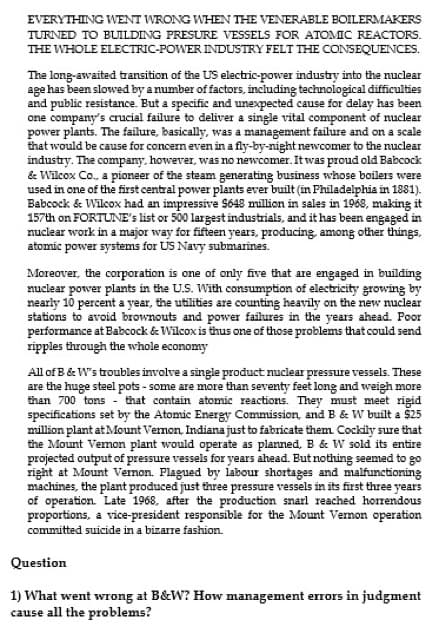1) What went wrong at B&W? How management errors in judgment cause all the problems?
1) What went wrong at B&W? How management errors in judgment cause all the problems?
Management, Loose-Leaf Version
13th Edition
ISBN:9781305969308
Author:Richard L. Daft
Publisher:Richard L. Daft
Chapter3: The Environment And Corporate Culture
Section: Chapter Questions
Problem 3ED
Related questions
Question

Transcribed Image Text:EVERYTHING WENT WRONG WHEN THE VENERABLE BOILERMAKERS
TURNED TO BUILDING PRESURE VESSELS FOR ATOMIC REACTORS.
THE WHOLE ELECTRIC-POWER INDUSTRY FELT THE CONSEQUENCES.
The long-awaited transition of the US electric-power industry into the nuclear
age has been slowed by a number of factors, including technological difficulties
and public resistance. But a specific and unexpected cause for delay has been
one company's crucial failure to deliver a single vital component of nuclear
power plants. The failure, basically, was a management failure and on a scale
that would be cause for concern even in a fly-by-night newcomer to the nuclear
industry. The company, however, was no newcomer. It was proud old Babcock
& Willcox Co..., a pioneer of the steam generating business whose boilers were
used in one of the first central power plants ever built (in Philadelphia in 1881).
Babcock & Wilcox had an impressive $648 million in sales in 1968, making it
157th on FORTUNE's list or 500 largest industrials, and it has been engaged in
nuclear work in a major way for fifteen years, producing, among other things,
atomic power systems for US Navy submarines.
Moreover, the corporation is one of only five that are engaged in building
nuclear power plants in the U.S. With consumption of electricity growing by
nearly 10 percent a year, the utilities are counting heavily on the new nuclear
stations to avoid brownouts and power failures in the years ahead. Poor
performance at Babcock & Wilcox is thus one of those problems that could send
ripples through the whole economy
that contain
All of B & W's troubles involve a single product nuclear pressure vessels. These
are the huge steel pots - some are more than seventy feet long and weigh more
than 700 tons
atomic reactions. They must meet rigid
specifications set by the Atomic Energy Commission, and B & W built a $25
million plant at Mount Vernon, Indiana just to fabricate them. Cockily sure that
the Mount Vernon plant would operate as planned. B & W sold its entire
projected output of pressure vessels for years ahead. But nothing seemed to go
right at Mount Vernon. Plagued by labour shortages and malfunctioning
machines, the plant produced just three pressure vessels in its first three years
of operation. Late 1968, after the production snarl reached horrendous
proportions, a vice-president responsible for the Mount Vernon operation
committed suicide in a bizarre fashion.
Question
1) What went wrong at B&W? How management errors in judgment
cause all the problems?
Expert Solution
This question has been solved!
Explore an expertly crafted, step-by-step solution for a thorough understanding of key concepts.
This is a popular solution!
Trending now
This is a popular solution!
Step by step
Solved in 2 steps

Recommended textbooks for you

Management, Loose-Leaf Version
Management
ISBN:
9781305969308
Author:
Richard L. Daft
Publisher:
South-Western College Pub


Management, Loose-Leaf Version
Management
ISBN:
9781305969308
Author:
Richard L. Daft
Publisher:
South-Western College Pub
